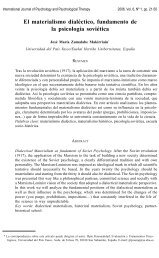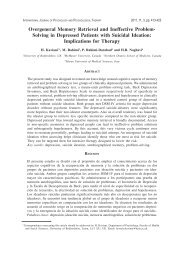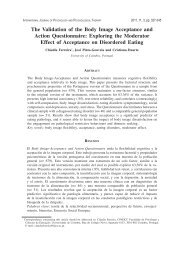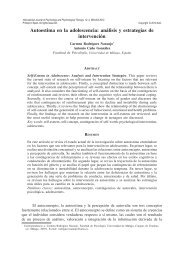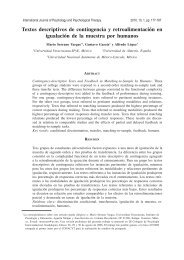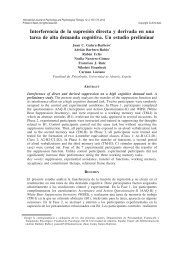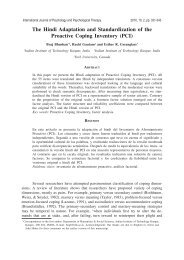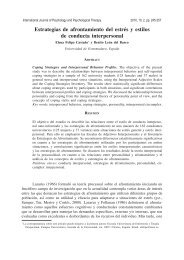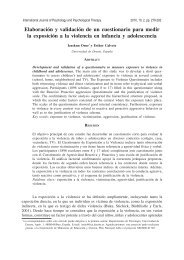Relación entre el clima familiar y el clima escolar: el rol de la ...
Relación entre el clima familiar y el clima escolar: el rol de la ...
Relación entre el clima familiar y el clima escolar: el rol de la ...
You also want an ePaper? Increase the reach of your titles
YUMPU automatically turns print PDFs into web optimized ePapers that Google loves.
International Journal of Psychology and Psychological Therapy 2009, 9, 1, 123-136<br />
R<strong>el</strong>ación <strong>entre</strong> <strong>el</strong> <strong>clima</strong> <strong>familiar</strong> y <strong>el</strong> <strong>clima</strong> <strong>esco<strong>la</strong>r</strong>: <strong>el</strong> <strong>rol</strong><br />
<strong>de</strong> <strong>la</strong> empatía, <strong>la</strong> actitud hacia <strong>la</strong> autoridad y <strong>la</strong> conducta<br />
violenta en <strong>la</strong> adolescencia<br />
David Moreno Ruiz *1 , Estefanía Estévez López 2 , Sergio Murgui Pérez 3<br />
Gonzalo Musitu Ochoa 4<br />
1<br />
Universidad <strong>de</strong> Valencia, España 2 Universidad Migu<strong>el</strong> Hernán<strong>de</strong>z, España<br />
3<br />
Universidad Católica San Vicente Mártir, España<br />
4<br />
Universidad Pablo O<strong>la</strong>vi<strong>de</strong>, España<br />
ABSTRACT<br />
The present study aims to analyse the r<strong>el</strong>ationship between family environment and school<br />
environment as perceived by the adolescent, examining the <strong>rol</strong>e that particu<strong>la</strong>r individual<br />
factors (as the empathic skill, the attitu<strong>de</strong> to institutional authority and the violent behaviour<br />
at school) p<strong>la</strong>yed in that association. The sample is composed of 1319 adolescents aged<br />
from 11 to 16 years old, and studying in seven secondary schools in the Valencian Community.<br />
A structural equation mod<strong>el</strong> was conducted to analyse the data. The results indicate that<br />
family environment is indirectly r<strong>el</strong>ated to social environment in the c<strong>la</strong>ssroom through the<br />
following links: quality of family environment showed a direct r<strong>el</strong>ationship with the empathy<br />
<strong>de</strong>v<strong>el</strong>opment, attitu<strong>de</strong> towards teachers and school as figures and institution of formal<br />
authority, as w<strong>el</strong>l as with the adolescent’s violent behaviour at school, which in turn<br />
contributed to shape their perception of school environment.<br />
Key words: family <strong>clima</strong>te, school <strong>clima</strong>te, violent behaviour, empathy, attitu<strong>de</strong> to authority.<br />
RESUMEN<br />
R<strong>el</strong>ationship between family and school environments: The <strong>rol</strong>e of empathy, attitu<strong>de</strong> to<br />
authority and violent behavior in adolescence. El presente estudio analiza <strong>la</strong> r<strong>el</strong>ación <strong>entre</strong><br />
<strong>el</strong> <strong>clima</strong> <strong>familiar</strong> y <strong>el</strong> <strong>clima</strong> <strong>esco<strong>la</strong>r</strong> percibidos por <strong>el</strong> adolescente, examinando <strong>el</strong> <strong>rol</strong> <strong>de</strong>sempeñado<br />
por <strong>de</strong>terminados factores individuales (capacidad empática, actitud hacia <strong>la</strong><br />
autoridad institucional y conducta violenta en <strong>la</strong> escu<strong>el</strong>a) en dicha asociación. La muestra<br />
se compone <strong>de</strong> 1319 adolescentes <strong>de</strong> eda<strong>de</strong>s <strong>entre</strong> 11 y 16 años, <strong>esco<strong>la</strong>r</strong>izados en siete<br />
centros <strong>de</strong> enseñanza secundaria <strong>de</strong> <strong>la</strong> Comunidad Valenciana. Para <strong>el</strong> análisis <strong>de</strong> los datos<br />
se ha calcu<strong>la</strong>do un mod<strong>el</strong>o <strong>de</strong> ecuaciones estructurales. Los resultados indican que <strong>el</strong> <strong>clima</strong><br />
<strong>familiar</strong> se r<strong>el</strong>aciona indirectamente con <strong>el</strong> <strong>clima</strong> social d<strong>el</strong> au<strong>la</strong> a través <strong>de</strong> <strong>la</strong>s siguientes<br />
asociaciones: <strong>la</strong> calidad d<strong>el</strong> <strong>clima</strong> <strong>familiar</strong> mostró una r<strong>el</strong>ación directa con <strong>el</strong> <strong>de</strong>sar<strong>rol</strong>lo <strong>de</strong><br />
<strong>la</strong> empatía, <strong>la</strong> actitud hacia <strong>el</strong> profesorado y <strong>la</strong> escu<strong>el</strong>a como figura e institución <strong>de</strong> autoridad<br />
formal, así como con <strong>el</strong> comportamiento violento d<strong>el</strong> adolescente en <strong>la</strong> escu<strong>el</strong>a que,<br />
a su vez, contribuyeron a <strong>de</strong>terminar <strong>la</strong> percepción d<strong>el</strong> adolescente d<strong>el</strong> <strong>clima</strong> <strong>esco<strong>la</strong>r</strong>.<br />
Pa<strong>la</strong>bras c<strong>la</strong>ve: <strong>clima</strong> <strong>familiar</strong>, <strong>clima</strong> <strong>esco<strong>la</strong>r</strong>, conducta violenta, empatía, actitud hacia<br />
autoridad.<br />
*<br />
La correspon<strong>de</strong>ncia sobre este artículo pue<strong>de</strong> dirigirse al primer autor: Departamento <strong>de</strong> Psicología Social, Facultad <strong>de</strong><br />
Psicología, Universidad <strong>de</strong> Valencia, Av. B<strong>la</strong>sco Ibáñez, 21, 46010 Valencia, España. E-mail: david.moreno-ruiz@uv.es.<br />
Agra<strong>de</strong>cimientos: esta estudio se ha <strong>el</strong>aborado en <strong>el</strong> marco d<strong>el</strong> proyecto <strong>de</strong> investigación SEJ2004-01742 subvencionado<br />
por <strong>el</strong> Ministerio <strong>de</strong> Educación y Ciencia <strong>de</strong> España y cofinanciado por <strong>la</strong> Dirección General <strong>de</strong> Investigación y Transferencia<br />
Tecnológica <strong>de</strong> <strong>la</strong> Consejería <strong>de</strong> Empresa, Universidad y Ciencia <strong>de</strong> Valencia.
124<br />
MORENO, ESTÉVEZ, MURGUI Y MUSITU<br />
Los problemas <strong>de</strong> comportamiento en <strong>la</strong> escu<strong>el</strong>a se presentan como una preocupación<br />
en aumento en numerosas socieda<strong>de</strong>s actuales, <strong>entre</strong> <strong>la</strong>s que también se encuentra<br />
nuestro contexto nacional. Las investigaciones que se han llevado a cabo en este<br />
ámbito comenzaron a finales <strong>de</strong> los años setenta con <strong>el</strong> pionero en <strong>el</strong> estudio <strong>de</strong> <strong>la</strong><br />
conducta violenta <strong>entre</strong> <strong>esco<strong>la</strong>r</strong>es, Dan Olweus (1978), y han continuado hasta <strong>la</strong> actualidad<br />
por <strong>la</strong> r<strong>el</strong>evancia e implicaciones d<strong>el</strong> tema que nos ocupa (Hodgins, 2008;<br />
Ortega, Calmaestra y Mora Merchán, 2008). Las causas <strong>de</strong> estos comportamientos<br />
parecen ser múltiples y, por tanto, se presenta como necesario analizar distintas variables<br />
que pue<strong>de</strong>n explicar, en cierta medida, <strong>el</strong> origen y mantenimiento <strong>de</strong> <strong>la</strong> conducta<br />
violenta en <strong>la</strong> adolescencia. En este sentido, para <strong>la</strong> comprensión <strong>de</strong> los problemas d<strong>el</strong><br />
comportamiento violento en <strong>la</strong> escu<strong>el</strong>a <strong>de</strong>bemos aten<strong>de</strong>r a <strong>la</strong>s características propias <strong>de</strong><br />
los implicados, incluyendo <strong>la</strong> percepción <strong>de</strong> los principales contextos sociales inmediatos<br />
a <strong>la</strong> persona, que en <strong>el</strong> caso d<strong>el</strong> adolescente, son <strong>la</strong> familia y <strong>la</strong> escu<strong>el</strong>a principalmente.<br />
Un contexto <strong>de</strong> r<strong>el</strong>evancia incuestionable en <strong>el</strong> <strong>de</strong>sar<strong>rol</strong>lo adolescente es <strong>la</strong> familia,<br />
<strong>de</strong>ntro d<strong>el</strong> cual po<strong>de</strong>mos subrayar <strong>el</strong> <strong>clima</strong> <strong>familiar</strong> como uno <strong>de</strong> los factores <strong>de</strong><br />
mayor importancia en <strong>el</strong> ajuste psicosocial d<strong>el</strong> adolescente (Estévez, Murgui, Musitu y<br />
Moreno, en prensa; Estévez, Musitu y Herrero, 2005; Martínez, 1996; Stevens, De<br />
Bour<strong>de</strong>audhuij y Van Oost, 2002). El <strong>clima</strong> <strong>familiar</strong> está constituido por <strong>el</strong> ambiente<br />
percibido e interpretado por los miembros que integran <strong>la</strong> familia, y ha mostrado ejercer<br />
una influencia significativa tanto en <strong>la</strong> conducta, como <strong>el</strong> <strong>de</strong>sar<strong>rol</strong>lo social, físico,<br />
afectivo e int<strong>el</strong>ectual <strong>de</strong> los integrantes (Schwarth y Pollishuke, 1995, Steinberg y<br />
Morris, 2001; Zimmer-Gembeck y Locke, 2007). Un <strong>clima</strong> <strong>familiar</strong> positivo hace referencia<br />
a un ambiente fundamentado en <strong>la</strong> cohesión afectiva <strong>entre</strong> padres e hijos, <strong>el</strong><br />
apoyo, <strong>la</strong> confianza e intimidad y <strong>la</strong> comunicación <strong>familiar</strong> abierta y empática; se ha<br />
constatado que estas dimensiones potencian <strong>el</strong> ajuste conductual y psicológico <strong>de</strong> los<br />
hijos (Li<strong>la</strong> y Bu<strong>el</strong>ga, 2003; Musitu y García, 2004; Van Aken, Van Lieshout, Scholte<br />
y Branje, 1999).<br />
Un <strong>clima</strong> <strong>familiar</strong> negativo, por <strong>el</strong> contrario, carente <strong>de</strong> los <strong>el</strong>ementos mencionados,<br />
se ha asociado con <strong>el</strong> <strong>de</strong>sar<strong>rol</strong>lo <strong>de</strong> problemas <strong>de</strong> comportamiento en niños y<br />
adolescentes (Bradshaw, G<strong>la</strong>ser, Calhoun y Bates, 2006; Dekovic, Wissink y Mejier,<br />
2004). Diversos estudios han mostrado que <strong>el</strong> <strong>clima</strong> <strong>familiar</strong> negativo caracterizado por<br />
los problemas <strong>de</strong> comunicación <strong>entre</strong> padres e hijos adolescentes, así como <strong>la</strong> carencia<br />
<strong>de</strong> afecto y apoyo, dificulta <strong>el</strong> <strong>de</strong>sar<strong>rol</strong>lo <strong>de</strong> <strong>de</strong>terminadas habilida<strong>de</strong>s sociales en los<br />
hijos que resultan fundamentales para <strong>la</strong> interacción social, tales como <strong>la</strong> capacidad <strong>de</strong><br />
i<strong>de</strong>ntificar soluciones no violentas a problemas interpersonales (Demaray y Malecki,<br />
2002; Lambert y Cashw<strong>el</strong>l, 2003) o <strong>la</strong> capacidad empática (Eisenberg-Berg y Mussen,<br />
1978; Henry, Sager y Plunkett, 1996).<br />
La empatía se conceptualiza como una respuesta afectiva caracterizada por <strong>la</strong><br />
aprehensión o comprensión d<strong>el</strong> estado emocional <strong>de</strong> otra persona y que es muy simi<strong>la</strong>r<br />
a lo que otra persona esta sintiendo o sería esperable que sintiera (Eisenberg y Fabes,<br />
1998). Es un proceso psicológico que varía <strong>de</strong> unas personas a otras y, por tanto, pue<strong>de</strong><br />
consi<strong>de</strong>rarse como un factor <strong>de</strong> diferencias individuales (Farrington y Jolliffe, 2001), y<br />
con una marcada influencia en <strong>el</strong> comportamiento (Eisenberg et al., 1996; Kaukiainen,<br />
© Intern. Jour. Psych. Psychol. Ther.
CLIMA FAMILIAR Y CLIMA ESCOLAR<br />
125<br />
et al., 1999). Así, recientes estudios han seña<strong>la</strong>do que los adolescentes implicados en<br />
conductas antisociales y violentas muestran frecuentemente un niv<strong>el</strong> bajo <strong>de</strong> empatía<br />
(An<strong>de</strong>rson y Bushman, 2002; Evans, Heriot y Friedman, 2002; Hoffman, 2000; Stormont,<br />
2002). Por otra parte, estos comportamientos su<strong>el</strong>en <strong>de</strong>sar<strong>rol</strong><strong>la</strong>rse en gran medida en <strong>el</strong><br />
contexto <strong>esco<strong>la</strong>r</strong>, afectando a su vez tanto <strong>la</strong> dinámica <strong>de</strong> <strong>la</strong> enseñanza como <strong>la</strong>s r<strong>el</strong>aciones<br />
sociales que se establecen en <strong>el</strong> au<strong>la</strong> (Cava, Musitu y Murgui, 2006).<br />
Otro contexto <strong>de</strong> suma r<strong>el</strong>evancia en <strong>el</strong> <strong>de</strong>sar<strong>rol</strong>lo psicosocial <strong>de</strong> niños y adolescentes<br />
es <strong>el</strong> entorno educativo formal. Al igual que en <strong>el</strong> caso <strong>de</strong> <strong>la</strong> familia, también<br />
en <strong>la</strong> escu<strong>el</strong>a, <strong>el</strong> <strong>clima</strong> o conjunto <strong>de</strong> percepciones subjetivas que profesores y alumnos<br />
comparten acerca <strong>de</strong> <strong>la</strong>s características d<strong>el</strong> contexto <strong>esco<strong>la</strong>r</strong> y d<strong>el</strong> au<strong>la</strong> (Trickett, Leone,<br />
Fink y Braaten, 1993), influye en <strong>el</strong> comportamiento <strong>de</strong> los alumnos (Cook, Murphy<br />
y Hunt, 2000; Cunningham, 2002). Se consi<strong>de</strong>ra que <strong>el</strong> <strong>clima</strong> <strong>esco<strong>la</strong>r</strong> es positivo cuando<br />
<strong>el</strong> alumno se siente cómodo, valorado y aceptado en un ambiente fundamentado en<br />
<strong>el</strong> apoyo, <strong>la</strong> confianza y <strong>el</strong> respeto mutuo <strong>entre</strong> profesorado y alumnos y <strong>entre</strong> iguales<br />
(Moos, 1974). Por tanto, y siguiendo a Yoneyama y Rigby (2006), los dos principales<br />
<strong>el</strong>ementos que constituyen <strong>el</strong> <strong>clima</strong> <strong>esco<strong>la</strong>r</strong> son: <strong>la</strong> calidad <strong>de</strong> <strong>la</strong> r<strong>el</strong>ación profesoralumno<br />
y <strong>la</strong> calidad <strong>de</strong> <strong>la</strong> interacción <strong>entre</strong> compañeros.<br />
Por un <strong>la</strong>do, <strong>la</strong> experiencia d<strong>el</strong> alumno con <strong>el</strong> profesorado, en muchas ocasiones<br />
primera figura <strong>de</strong> autoridad formal para los jóvenes (Emler, Ohana y Dickinson, 1990),<br />
contribuirá tanto a <strong>la</strong> percepción que <strong>el</strong> adolescente <strong>de</strong>sar<strong>rol</strong><strong>la</strong> sobre <strong>el</strong> contexto <strong>esco<strong>la</strong>r</strong><br />
y otros sistemas formales (Emler y Reicher, 1995; Molpeceres, Llinares y Bernard,<br />
1999), como a su comportamiento en <strong>el</strong> au<strong>la</strong> (Estévez, Herrero, Martínez y Musitu,<br />
2006; Estévez, Murgui, Moreno y Musitu, 2007). Estudios previos han puesto <strong>de</strong> manifiesto<br />
que <strong>la</strong> interacción negativa <strong>entre</strong> profesores y alumnos pue<strong>de</strong> traducirse en conductas<br />
antisociales y violentas en <strong>la</strong> escu<strong>el</strong>a (B<strong>la</strong>nkemeyer, F<strong>la</strong>nnery y Vazsonyi, 2002; Reinke<br />
y Herman, 2002). Por otro <strong>la</strong>do, <strong>la</strong> amistad en <strong>el</strong> grupo <strong>de</strong> iguales en <strong>la</strong> escu<strong>el</strong>a pue<strong>de</strong><br />
constituir tanto un factor <strong>de</strong> protección como <strong>de</strong> riesgo en <strong>el</strong> <strong>de</strong>sar<strong>rol</strong>lo <strong>de</strong> problemas<br />
<strong>de</strong> comportamiento (Jiménez, Moreno, Murgui y Musitu, 2008); <strong>la</strong> amistad pue<strong>de</strong> significar<br />
una oportunidad única para <strong>el</strong> aprendizaje <strong>de</strong> valores, actitu<strong>de</strong>s y habilida<strong>de</strong>s<br />
sociales como <strong>el</strong> manejo d<strong>el</strong> conflicto y <strong>la</strong> empatía (Hartup, 1996; Laursen, 1995), pero<br />
también pue<strong>de</strong> ejercer una influencia <strong>de</strong>cisiva en <strong>la</strong> implicación en conductas violentas,<br />
si así es <strong>el</strong> comportamiento d<strong>el</strong> grupo <strong>de</strong> iguales en <strong>el</strong> que <strong>el</strong> adolescente se adscribe<br />
(Barnow, Lucht y Freyberger, 2005; Dishion, 2000).<br />
Todos estos trabajos muestran <strong>la</strong> r<strong>el</strong>ación existente <strong>entre</strong> <strong>de</strong>terminadas características<br />
<strong>de</strong> los contextos más inmediatos al adolescente, familia y escu<strong>el</strong>a, y <strong>el</strong> <strong>de</strong>sar<strong>rol</strong>lo<br />
bien <strong>de</strong> problemas comportamentales, bien <strong>de</strong> características individuales que aumentan<br />
<strong>la</strong> probabilidad <strong>de</strong> <strong>de</strong>sar<strong>rol</strong>lo <strong>de</strong> esos problemas, como <strong>la</strong> falta <strong>de</strong> empatía. Sin<br />
embargo, <strong>la</strong> literatura científica presenta una <strong>la</strong>guna mucho mayor en r<strong>el</strong>ación con <strong>el</strong><br />
análisis conjunto d<strong>el</strong> <strong>rol</strong> <strong>de</strong>sempeñado por <strong>la</strong> familia y <strong>la</strong> escu<strong>el</strong>a en <strong>el</strong> ajuste<br />
comportamental adolescente y más aún en examinar cómo los problemas <strong>de</strong> conducta<br />
en <strong>la</strong> escu<strong>el</strong>a pue<strong>de</strong>n a su vez afectar <strong>el</strong> <strong>clima</strong> percibido en <strong>el</strong> au<strong>la</strong>, <strong>de</strong>senca<strong>de</strong>nándose<br />
<strong>de</strong> ese modo una espiral <strong>de</strong> influencia negativa conducta-ambiente. Ahondar en <strong>la</strong><br />
comprensión <strong>de</strong> estas r<strong>el</strong>aciones pasa por analizar <strong>el</strong> vínculo existente <strong>entre</strong> distintas<br />
variables individuales d<strong>el</strong> adolescente, atendiendo, por ejemplo, a <strong>la</strong> percepción <strong>de</strong> éste<br />
© Intern. Jour. Psych. Psychol. Ther.
126<br />
MORENO, ESTÉVEZ, MURGUI Y MUSITU<br />
<strong>de</strong> los <strong>clima</strong>s <strong>familiar</strong> y <strong>esco<strong>la</strong>r</strong> y observar <strong>la</strong> r<strong>el</strong>ación que se establece <strong>entre</strong> ambos<br />
ambientes percibidos. Estos análisis nos permitirán avanzar en <strong>la</strong> comprensión <strong>de</strong> <strong>la</strong><br />
asociación familia-escu<strong>el</strong>a y problemas <strong>de</strong> comportamiento en <strong>la</strong> adolescencia, lo que<br />
conlleva a su vez c<strong>la</strong>ras implicaciones prácticas para <strong>el</strong> <strong>de</strong>sar<strong>rol</strong>lo <strong>de</strong> programas más<br />
eficaces en <strong>la</strong> promoción <strong>de</strong> <strong>la</strong> convivencia <strong>esco<strong>la</strong>r</strong> saludable y pacífica.<br />
Un estudio que se presenta como necesario comentar en este sentido, es <strong>el</strong><br />
trabajo clásico <strong>de</strong> Bernstein en los años 70, don<strong>de</strong> se concluye que <strong>la</strong> actitud negativa<br />
o positiva d<strong>el</strong> adolescente hacia <strong>el</strong> profesorado y <strong>la</strong> escu<strong>el</strong>a pue<strong>de</strong> venir <strong>de</strong>terminada<br />
por <strong>la</strong> percepción que tiene <strong>la</strong> familia d<strong>el</strong> ámbito <strong>esco<strong>la</strong>r</strong> y <strong>de</strong> dichas figuras <strong>de</strong> autoridad<br />
formal. Es posible, por tanto, que <strong>la</strong> familia constituya un referente esencial en<br />
<strong>la</strong> configuración <strong>de</strong> <strong>la</strong> actitud hacia <strong>la</strong> autoridad institucional (como <strong>la</strong> escu<strong>el</strong>a y <strong>el</strong><br />
profesorado) que, a su vez, ha mostrado tener una influencia <strong>de</strong>cisiva en <strong>el</strong> comportamiento<br />
violento d<strong>el</strong> adolescente (Emler y Reicher, 1995; Hoge, Andrews y Leicheid,<br />
1996). Así, tanto <strong>el</strong> entorno <strong>familiar</strong> como <strong>la</strong> actitud hacia <strong>la</strong> autoridad parecen ser dos<br />
factores <strong>de</strong> suma r<strong>el</strong>evancia en <strong>la</strong> explicación <strong>de</strong> ciertos comportamientos violentos en<br />
<strong>la</strong> adolescencia, tanto <strong>de</strong>ntro como fuera d<strong>el</strong> contexto <strong>esco<strong>la</strong>r</strong> (Decker, Dona y Christenson,<br />
2007; Gottfredson y Hirschi, 1990).<br />
Teniendo en cuenta lo anteriormente expuesto, <strong>el</strong> principal objetivo d<strong>el</strong> presente<br />
estudio fue examinar <strong>la</strong> r<strong>el</strong>ación existente <strong>entre</strong> ambos contextos a partir <strong>de</strong> <strong>la</strong> percepción<br />
d<strong>el</strong> adolescente <strong>de</strong> los <strong>clima</strong>s <strong>familiar</strong> y <strong>esco<strong>la</strong>r</strong>, analizando <strong>el</strong> <strong>rol</strong> <strong>de</strong>sempeñado<br />
por <strong>de</strong>terminados factores individuales (tales como <strong>la</strong> capacidad empática, <strong>la</strong> actitud<br />
hacia <strong>la</strong> autoridad y <strong>la</strong> conducta violenta) en <strong>la</strong> asociación <strong>entre</strong> <strong>el</strong>los. Concretamente,<br />
<strong>la</strong>s hipótesis <strong>de</strong> partida son <strong>la</strong>s siguientes: (1) <strong>la</strong> percepción d<strong>el</strong> <strong>clima</strong> <strong>familiar</strong> se<br />
r<strong>el</strong>acionará directa y positivamente con <strong>la</strong> percepción d<strong>el</strong> <strong>clima</strong> <strong>esco<strong>la</strong>r</strong>; (2) <strong>la</strong> percepción<br />
d<strong>el</strong> <strong>clima</strong> <strong>familiar</strong> se asociará indirectamente con <strong>la</strong> percepción d<strong>el</strong> <strong>clima</strong> <strong>esco<strong>la</strong>r</strong><br />
a través <strong>de</strong> <strong>la</strong> actitud hacia <strong>la</strong> autoridad institucional, <strong>la</strong> empatía y <strong>la</strong> conducta violenta.<br />
Por tanto, preten<strong>de</strong>mos analizar en qué medida <strong>de</strong>terminadas habilida<strong>de</strong>s, actitu<strong>de</strong>s y<br />
comportamientos adquiridos o potenciados en <strong>el</strong> ambiente <strong>familiar</strong> pue<strong>de</strong>n afectar <strong>la</strong>s<br />
r<strong>el</strong>aciones que se <strong>de</strong>sar<strong>rol</strong><strong>la</strong>n en otro contexto <strong>de</strong> socialización <strong>de</strong> suma r<strong>el</strong>evancia en<br />
<strong>la</strong> adolescencia, como es <strong>la</strong> escu<strong>el</strong>a. Ahondar en <strong>el</strong> conocimiento <strong>de</strong> estas r<strong>el</strong>aciones<br />
pue<strong>de</strong> traducirse, como venimos apuntando, en un c<strong>la</strong>ro beneficio para <strong>el</strong> diseño <strong>de</strong><br />
estrategias preventivas frente al <strong>de</strong>sar<strong>rol</strong>lo <strong>de</strong> problemas <strong>de</strong> conducta en <strong>la</strong> escu<strong>el</strong>a, así<br />
como dirigidas a <strong>la</strong> mejora d<strong>el</strong> <strong>clima</strong> en <strong>el</strong> au<strong>la</strong> y, por en<strong>de</strong>, <strong>de</strong> <strong>la</strong> convivencia en los<br />
centros educativos.<br />
MÉTODO<br />
Muestra<br />
Participaron en <strong>la</strong> investigación un total <strong>de</strong> 1319 adolescentes <strong>de</strong> ambos sexos<br />
(53% chicas y 47% chicos) y eda<strong>de</strong>s comprendidas <strong>entre</strong> los 11 y los 16 años (edad<br />
media 13,7; <strong>de</strong>sviación típica 1,5), <strong>esco<strong>la</strong>r</strong>izados en siete centros educativos <strong>de</strong> enseñanza<br />
secundaria ubicados en <strong>la</strong> Comunidad Valenciana (provincias <strong>de</strong> Alicante y Valencia).<br />
© Intern. Jour. Psych. Psychol. Ther.
CLIMA FAMILIAR Y CLIMA ESCOLAR<br />
127<br />
Procedimiento<br />
La s<strong>el</strong>ección <strong>de</strong> los centros educativos se llevó a cabo <strong>de</strong> manera aleatoria <strong>entre</strong><br />
<strong>el</strong> total <strong>de</strong> escu<strong>el</strong>as públicas <strong>de</strong> enseñanza secundaria obligatoria <strong>de</strong> <strong>la</strong> Comunidad<br />
Valenciana, una vez que esta información fue facilitada por los ayuntamientos correspondientes.<br />
En cada una <strong>de</strong> estas escu<strong>el</strong>as, se administró una batería <strong>de</strong> cuestionarios<br />
a todos los alumnos <strong>esco<strong>la</strong>r</strong>izados en los cuatro cursos <strong>de</strong> E.S.O., constituyendo una<br />
muestra <strong>de</strong> 1.319 adolescentes. Tras <strong>la</strong> obtención <strong>de</strong> permiso y consentimiento por parte<br />
<strong>de</strong> <strong>la</strong> dirección <strong>de</strong> los centros educativos, se realizó un seminario informativo con <strong>la</strong><br />
p<strong>la</strong>ntil<strong>la</strong> <strong>de</strong> profesorado para explicar los objetivos, importancia y alcance d<strong>el</strong> presente<br />
estudio. Paral<strong>el</strong>amente, se envió una carta explicativa <strong>de</strong> <strong>la</strong> investigación a los padres<br />
y madres <strong>de</strong> los alumnos don<strong>de</strong>, a<strong>de</strong>más, se solicitó que expresaran por escrito su<br />
consentimiento en r<strong>el</strong>ación con <strong>la</strong> participación <strong>de</strong> su hijo/a. Los adolescentes cumplimentaron<br />
<strong>la</strong> batería <strong>de</strong> instrumentos en sus au<strong>la</strong>s habituales durante un período regu<strong>la</strong>r<br />
<strong>de</strong> c<strong>la</strong>se <strong>de</strong> aproximadamente 45 minutos <strong>de</strong> duración. En todos los casos, <strong>la</strong> participación<br />
fue voluntaria, anónima, y con previo consentimiento paterno.<br />
Instrumentos<br />
Esca<strong>la</strong> <strong>de</strong> Clima Social Familiar (FES), <strong>de</strong>sar<strong>rol</strong><strong>la</strong>da por Moos, Moos y Trickett<br />
(1989). Esta esca<strong>la</strong> se compone <strong>de</strong> 27 ítems que informan sobre <strong>el</strong> <strong>clima</strong> social y <strong>la</strong>s<br />
r<strong>el</strong>aciones interpersonales existentes en <strong>la</strong> familia, con alternativas <strong>de</strong> respuesta formu<strong>la</strong>das<br />
en verda<strong>de</strong>ro o falso. El instrumento mi<strong>de</strong> tres dimensiones: cohesión (ejemplo<br />
“En mi familia hay un fuerte sentimiento <strong>de</strong> unión”), expresividad (ejemplo “En casa<br />
hab<strong>la</strong>mos abiertamente <strong>de</strong> lo que nos parece o queremos”) y conflicto (ejemplo “Los<br />
miembros <strong>de</strong> <strong>la</strong> familia estamos enfrentados unos con otros”). La fiabilidad <strong>de</strong> <strong>la</strong>s<br />
subesca<strong>la</strong>s obtenida en <strong>el</strong> presente estudio según <strong>el</strong> alpha <strong>de</strong> Cronbach fue <strong>de</strong> .85, .80<br />
y .86 respectivamente. La consistencia interna <strong>de</strong> <strong>la</strong> esca<strong>la</strong> original es <strong>de</strong> .78, .69 y .75.<br />
La fiabilidad test-retest es <strong>de</strong> .86 para cohesión, .73 para expresividad y .85 para<br />
conflicto (Moos, Moos y Trickett, 1989).<br />
Esca<strong>la</strong> <strong>de</strong> Clima Social Esco<strong>la</strong>r (CES), <strong>el</strong>aborada por Moos, Moos y Trickett<br />
(1989). Esta esca<strong>la</strong> se compone <strong>de</strong> 27 ítems que informan acerca d<strong>el</strong> <strong>clima</strong> social y <strong>la</strong>s<br />
r<strong>el</strong>aciones interpersonales existentes en <strong>el</strong> au<strong>la</strong>, con alternativas <strong>de</strong> respuesta formu<strong>la</strong>das<br />
en verda<strong>de</strong>ro o falso. El instrumento mi<strong>de</strong> tres dimensiones: implicación (ejemplo<br />
“Los alumnos prestan atención a lo que dice <strong>el</strong> profesor”), ayuda d<strong>el</strong> profesor (ejemplo<br />
“El profesor muestra interés por sus alumnos”) y afiliación (ejemplo “En esta c<strong>la</strong>se se<br />
hacen muchas amista<strong>de</strong>s”). La fiabilidad <strong>de</strong> <strong>la</strong>s subesca<strong>la</strong>s según <strong>el</strong> alpha <strong>de</strong> Cronbach<br />
es <strong>de</strong> .84, .79 y .89 respectivamente. La consistencia interna <strong>de</strong> <strong>la</strong> esca<strong>la</strong> original es <strong>de</strong><br />
.85 para implicación, .74 para afiliación y .84 para ayuda. La fiabilidad test-retest es<br />
<strong>de</strong> .87, .73 y .89 respectivamente (Moos, Moos y Trickett, 1989).<br />
Índice <strong>de</strong> Empatía para Niños y Adolescentes (IECA) <strong>de</strong> Bryant (1982). Esta<br />
esca<strong>la</strong> se compone <strong>de</strong> 22 ítems, a través <strong>de</strong> los cuales obtenemos una medida general<br />
d<strong>el</strong> grado <strong>de</strong> empatía experimentado por <strong>el</strong> adolescente en distintas situaciones p<strong>la</strong>nteadas<br />
(ejemplo “Me dan ganas <strong>de</strong> llorar cuando veo a un chico llorando”, “Me siento mal<br />
© Intern. Jour. Psych. Psychol. Ther.
128<br />
MORENO, ESTÉVEZ, MURGUI Y MUSITU<br />
cuando veo que se hace daño a una chica”). Las respuestas van <strong>de</strong> 1 -nunca- a 4 -<br />
siempre. La esca<strong>la</strong> presentó un coeficiente <strong>de</strong> fiabilidad en nuestros datos <strong>de</strong> .81. La<br />
consistencia interna <strong>de</strong> <strong>la</strong> esca<strong>la</strong> original es <strong>de</strong> .67 y se han encontrado diferencias en<br />
empatía en función d<strong>el</strong> sexo, obteniendo <strong>la</strong>s mujeres puntuaciones más altas que los<br />
hombres (Bryant, 1982).<br />
Esca<strong>la</strong> <strong>de</strong> Actitud hacia <strong>la</strong> Autoridad Institucional, adaptada <strong>de</strong> Reicher y Emler<br />
(1995). Esta esca<strong>la</strong> se compone <strong>de</strong> 10 ítems con un rango <strong>de</strong> respuesta <strong>de</strong> 1 -totalmente<br />
en <strong>de</strong>sacuerdo- a 4 -totalmente <strong>de</strong> acuerdo- que mi<strong>de</strong>n <strong>la</strong> actitud d<strong>el</strong> adolescente hacia<br />
<strong>la</strong> escu<strong>el</strong>a y <strong>el</strong> profesorado como institución y figuras <strong>de</strong> autoridad formal (ejemplo “Es<br />
normal <strong>de</strong>sobe<strong>de</strong>cer a los profesores si no hay castigos.”, “Si una reg<strong>la</strong> <strong>esco<strong>la</strong>r</strong> no te<br />
gusta, lo mejor es saltárs<strong>el</strong>a.”). La esca<strong>la</strong> original también aporta una medida <strong>de</strong> <strong>la</strong><br />
actitud hacia <strong>la</strong> policía y <strong>la</strong> ley, no consi<strong>de</strong>rada en <strong>el</strong> presente estudio. El coeficiente<br />
<strong>de</strong> fiabilidad obtenido para esta esca<strong>la</strong> en nuestros datos fue <strong>de</strong> .71. La fiabilidad<br />
original <strong>de</strong> esta esca<strong>la</strong> es <strong>de</strong> .73. Esta esca<strong>la</strong> muestra corr<strong>el</strong>aciones positivas con <strong>la</strong><br />
implicación en conductas disruptivas y violentas, y negativas con medidas <strong>de</strong> integración<br />
<strong>esco<strong>la</strong>r</strong> y rendimiento académico (Emler y Reicher, 1995, 2005).<br />
Esca<strong>la</strong> <strong>de</strong> Conducta Violenta, adaptada <strong>de</strong> Little, Henrich, Jones y Hawley (2003).<br />
Se utilizó una esca<strong>la</strong> <strong>de</strong> violencia manifiesta que mi<strong>de</strong> con 12 ítems y con un rango <strong>de</strong><br />
respuesta <strong>de</strong> 1 -muy en <strong>de</strong>sacuerdo- a 4 -muy <strong>de</strong> acuerdo-, comportamientos que implican<br />
una confrontación directa hacia otros, como empujar, pegar, amenazar o insultar.<br />
Este instrumento <strong>de</strong> medida consta <strong>de</strong> tres dimensiones que evalúan distintos subtipos<br />
<strong>de</strong> violencia manifiesta: violencia manifiesta pura (ejemplo “Soy una persona que se<br />
p<strong>el</strong>ea con los <strong>de</strong>más”), violencia manifiesta reactiva (ejemplo “Cuando alguien me<br />
amenaza, yo le amenazo también”) y violencia manifiesta instrumental (ejemplo “Pego,<br />
doy patadas o puñetazos para conseguir lo que quiero”). El coeficiente <strong>de</strong> fiabilidad<br />
alfa <strong>de</strong> Cronbach obtenido en nuestros datos para <strong>la</strong>s subesca<strong>la</strong>s fue <strong>de</strong> .82, .73 y .78<br />
respectivamente. La fiabilidad <strong>de</strong> <strong>la</strong>s subesca<strong>la</strong>s según <strong>el</strong> alpha <strong>de</strong> Cronbach es <strong>de</strong> .79<br />
para Agresión manifiesta pura, .82 para Agresión manifiesta reactiva, .84 para Agresión<br />
manifiesta instrumental. Esta esca<strong>la</strong> presenta corr<strong>el</strong>aciones positivas con medidas <strong>de</strong><br />
baja autoestima, ansiedad y distrés psicológico en <strong>la</strong>s víctimas (Prinstein, Boergers y<br />
Vernber, 2001).<br />
RESULTADOS<br />
En primer lugar, se calcu<strong>la</strong>ron <strong>la</strong>s corr<strong>el</strong>aciones <strong>de</strong> Pearson <strong>entre</strong> todas <strong>la</strong>s variables<br />
objeto <strong>de</strong> estudio. Estos datos, que se presentan en <strong>la</strong> tab<strong>la</strong> 1, mostraron r<strong>el</strong>aciones<br />
significativas <strong>entre</strong> <strong>la</strong>s dimensiones d<strong>el</strong> <strong>clima</strong> <strong>familiar</strong>, <strong>la</strong> empatía, <strong>la</strong> actitud<br />
positiva hacia <strong>la</strong> autoridad, <strong>la</strong> conducta violenta y <strong>el</strong> <strong>clima</strong> <strong>esco<strong>la</strong>r</strong>. Por tanto estas<br />
variables fueron incluidas en los análisis <strong>de</strong> regresión posteriores. Las tres dimensiones<br />
referidas a <strong>la</strong> conducta violenta presentaron corr<strong>el</strong>aciones negativas con <strong>el</strong> resto <strong>de</strong><br />
variables consi<strong>de</strong>radas en este estudio, mientras que <strong>la</strong> empatía, <strong>la</strong> actitud positiva hacia<br />
<strong>la</strong> autoridad y <strong>la</strong>s dimensiones que hacen referencia a <strong>la</strong> familia y a <strong>la</strong> escu<strong>el</strong>a<br />
corr<strong>el</strong>acionaron positivamente <strong>entre</strong> sí.<br />
© Intern. Jour. Psych. Psychol. Ther.
CLIMA FAMILIAR Y CLIMA ESCOLAR<br />
129<br />
Tab<strong>la</strong> 1. Matriz <strong>de</strong> corr<strong>el</strong>aciones <strong>entre</strong> <strong>la</strong>s variables observables d<strong>el</strong> mod<strong>el</strong>o.<br />
Variables 1 2 3 4 5 6 7 8 9 10 11<br />
1. Cohesión -<br />
2. Expresividad .46 ** -<br />
3. Conflicto .57 ** .24 * * -<br />
4. Implicación .10 ** .05 .05 -<br />
5. Afiliación .29 *** .1 8 *** .20 *** .36 *** -<br />
6.Ayuda Profesor .28 ** .15 * * .19 ** .25 ** .19 *** -<br />
7.Empatía .18 ** .15 * * .12 ** .07 * .07 * .14 ** -<br />
8. Actitud Autoridad .22 ** .14 * * .15 ** .26 ** .11 *** .38 ** .26 ** -<br />
9. Violencia Pura -.24 ** -.11 * * -.24 ** -12 ** -.08 ** -.18 * * -.24 ** -.28 ** -<br />
10. Violencia Reactiva -.25 ** -.11 * * -.21 ** -.17 * * -.11 *** -.17 * * -.25 ** -.31 ** .60 ** -<br />
11. Violencia Instrumental-.22 ** -.11 * * -.21 ** -.14 * * -.09 ** -.16 * * -.27 ** -.25 ** .69 ** .5 9 * * -<br />
Nota: <strong>la</strong>s variables están estandarizadas.<br />
*p
130<br />
MORENO, ESTÉVEZ, MURGUI Y MUSITU<br />
Tab<strong>la</strong> 2. Estimaciones <strong>de</strong> parámetros, errores estándar y probabilidad asociada.<br />
Variables<br />
Clima Familiar<br />
Conflicto<br />
Expresividad<br />
Cohesión<br />
Clima Esco<strong>la</strong>r<br />
Afiliación<br />
Ayuda Profesor<br />
Cargas<br />
factoriales<br />
.648 ***<br />
.523 ***<br />
1ª<br />
.740 ***<br />
.933 ***<br />
1ª<br />
Errores<br />
estándar<br />
.053<br />
.048<br />
0<br />
.091<br />
.104<br />
0<br />
Implicación<br />
Empatía 1ª 0<br />
Actitud hacia <strong>la</strong> Autoridad 1ª 0<br />
Conducta Violenta<br />
Reactiva<br />
Instrumental<br />
Pura<br />
a<br />
Fi jados en 1.00 durant e <strong>la</strong> estimación.<br />
***p < .001 (bil ateral)<br />
.911 ***<br />
.921 ***<br />
1ª<br />
.043<br />
.040<br />
0<br />
riores a .05 (Batista y Coen<strong>de</strong>rs, 2000). En <strong>la</strong> figura 1 se muestra <strong>la</strong> representación<br />
gráfica d<strong>el</strong> mod<strong>el</strong>o estructural final con los coeficientes estandarizados y su probabilidad<br />
asociada. En esta figura se pue<strong>de</strong>n observar distintas r<strong>el</strong>aciones <strong>de</strong> influencia tanto<br />
directa como indirecta en <strong>el</strong> <strong>clima</strong> <strong>esco<strong>la</strong>r</strong>.<br />
El mod<strong>el</strong>o estructural final mostró <strong>la</strong> existencia <strong>de</strong> r<strong>el</strong>aciones indirectas <strong>entre</strong> <strong>el</strong><br />
<strong>clima</strong> <strong>familiar</strong> y <strong>el</strong> <strong>clima</strong> <strong>esco<strong>la</strong>r</strong> a través <strong>de</strong> <strong>la</strong> empatía, <strong>la</strong> actitud positiva hacia <strong>la</strong><br />
autoridad y <strong>la</strong> conducta violenta. No se observó, sin embargo, una asociación directa<br />
<strong>entre</strong> los <strong>clima</strong>s <strong>familiar</strong> y <strong>esco<strong>la</strong>r</strong>: <strong>la</strong> r<strong>el</strong>ación directa <strong>entre</strong> estas variables <strong>de</strong>jó <strong>de</strong> ser<br />
significativa cuando se introdujeron en <strong>la</strong> ecuación <strong>la</strong>s tres variables intermedias mencionadas.<br />
Los resultados mostraron, por un <strong>la</strong>do, una influencia directa y positiva d<strong>el</strong><br />
<strong>clima</strong> <strong>familiar</strong> en <strong>la</strong> actitud d<strong>el</strong> adolescente hacia <strong>la</strong> autoridad formal (β= .24, p
CLIMA FAMILIAR Y CLIMA ESCOLAR<br />
131<br />
C lima<br />
Familiar<br />
.24***<br />
Actitud<br />
Autoridad<br />
Institucional<br />
.59***<br />
Clima<br />
Esco<strong>la</strong>r<br />
.18***<br />
.24***<br />
-.23***<br />
-.18**<br />
Empatía<br />
-.22***<br />
Conducta<br />
Violenta<br />
-.20***<br />
Figura 1. Mod<strong>el</strong>o estructural final. Las líneas continuas representan r<strong>el</strong>aciones significativas<br />
<strong>entre</strong> variables. Los círculos representan variables <strong>la</strong>tentes y los cuadrados variables<br />
con un único indicador. Significación <strong>de</strong> los coeficientes: *** p
132<br />
MORENO, ESTÉVEZ, MURGUI Y MUSITU<br />
institucional; <strong>de</strong> esta manera, <strong>la</strong> combinación <strong>de</strong> un bajo niv<strong>el</strong> <strong>de</strong> empatía y <strong>de</strong> actitu<strong>de</strong>s<br />
negativas hacia <strong>la</strong> escu<strong>el</strong>a y <strong>el</strong> profesorado parecen constituir dos r<strong>el</strong>evantes factores <strong>de</strong><br />
riesgo frente <strong>el</strong> <strong>de</strong>sar<strong>rol</strong>lo <strong>de</strong> comportamientos violentos en <strong>la</strong> escu<strong>el</strong>a. En otras pa<strong>la</strong>bras,<br />
lo que nuestros resultados sugieren es que <strong>la</strong> interacción negativa <strong>entre</strong> padres e<br />
hijos (existencia <strong>de</strong> frecuentes conflictos, falta <strong>de</strong> comunicación <strong>familiar</strong> y <strong>de</strong> cohesión<br />
afectiva), afecta a otros niv<strong>el</strong>es <strong>de</strong> r<strong>el</strong>ación social en los adolescentes, por ejemplo con<br />
sus iguales y con <strong>el</strong> profesorado como figuras <strong>de</strong> autoridad formal. Con sus iguales<br />
porque no <strong>de</strong>sar<strong>rol</strong><strong>la</strong>n a<strong>de</strong>cuadamente <strong>la</strong> habilidad empática, que en buena medida se<br />
fomenta con <strong>la</strong> expresión <strong>de</strong> sentimientos en <strong>el</strong> seno <strong>familiar</strong> (Jolliffe y Farrington,<br />
2004), lo que aumenta <strong>la</strong> probabilidad <strong>de</strong> que se <strong>de</strong>sar<strong>rol</strong>len comportamientos hostiles<br />
hacia <strong>el</strong> otro, dificultando así <strong>la</strong> convivencia en <strong>el</strong> contexto d<strong>el</strong> au<strong>la</strong>. Y con figuras <strong>de</strong><br />
autoridad formal, como <strong>la</strong> escu<strong>el</strong>a y <strong>el</strong> profesorado, puesto que si los padres como<br />
figuras <strong>de</strong> autoridad informal, no son mod<strong>el</strong>os a<strong>de</strong>cuados, los adolescentes transfieren<br />
este tipo <strong>de</strong> actitu<strong>de</strong>s a otros contextos formales fuera d<strong>el</strong> hogar. Este resultado se<br />
r<strong>el</strong>aciona con los encontrados en trabajos previos que seña<strong>la</strong>n <strong>la</strong> actitud positiva hacia<br />
<strong>la</strong> autoridad y <strong>el</strong> <strong>de</strong>sar<strong>rol</strong>lo <strong>de</strong> <strong>la</strong> empatía como factores <strong>de</strong> prevención y protección<br />
frente a <strong>la</strong> conducta violenta en <strong>el</strong> au<strong>la</strong> (Díaz Aguado, 2005; Garaigordobil, 2002; Hoge<br />
et al., 1996; Johnson y Johnson, 1999). Así, siguiendo <strong>la</strong> lógica d<strong>el</strong> mod<strong>el</strong>o puesto a<br />
prueba en <strong>el</strong> presente estudio, <strong>el</strong> comportamiento violento, influenciado por actitu<strong>de</strong>s<br />
negativas d<strong>el</strong> adolescente hacia <strong>el</strong> profesorado y <strong>la</strong> escu<strong>el</strong>a (aprendidos o motivados por<br />
<strong>de</strong>sajustes y carencias en <strong>el</strong> contexto <strong>familiar</strong>), ejerce un impacto negativo en <strong>el</strong> <strong>clima</strong><br />
social d<strong>el</strong> au<strong>la</strong>. Este último resultado va en <strong>la</strong> línea <strong>de</strong> los obtenidos por Trianes,<br />
Sánchez y Muñoz (2001) que observaron que <strong>el</strong> <strong>de</strong>sar<strong>rol</strong>lo <strong>de</strong> conductas violentas<br />
contribuye a generar un <strong>clima</strong> social en <strong>el</strong> au<strong>la</strong> más tenso y negativo.<br />
La r<strong>el</strong>ación observada en <strong>el</strong> mod<strong>el</strong>o propuesto <strong>entre</strong> <strong>el</strong> <strong>clima</strong> <strong>familiar</strong> y <strong>el</strong> <strong>clima</strong><br />
<strong>esco<strong>la</strong>r</strong> a través <strong>de</strong> <strong>la</strong> actitud hacia <strong>la</strong> autoridad institucional, constata <strong>el</strong> resultado<br />
obtenido por Bernstein (1998), quien <strong>de</strong>fine <strong>la</strong> familia como un contexto <strong>de</strong> vital importancia<br />
en <strong>la</strong> configuración <strong>de</strong> <strong>la</strong> actitud d<strong>el</strong> adolescente hacia <strong>el</strong> profesorado y <strong>la</strong><br />
escu<strong>el</strong>a. Pero, a<strong>de</strong>más, nuestro mod<strong>el</strong>o subraya <strong>la</strong> estrecha r<strong>el</strong>ación que se da <strong>entre</strong> <strong>la</strong><br />
actitud hacia <strong>la</strong> autoridad y <strong>el</strong> <strong>clima</strong> <strong>esco<strong>la</strong>r</strong>. Es <strong>de</strong>cir, un <strong>clima</strong> <strong>familiar</strong> negativo,<br />
<strong>de</strong>terminado por problemas <strong>de</strong> comunicación y carencias afectivas <strong>entre</strong> los miembros<br />
<strong>de</strong> <strong>la</strong> familia, pue<strong>de</strong> influir negativamente en <strong>el</strong> <strong>de</strong>sar<strong>rol</strong>lo psicosocial d<strong>el</strong> adolescente<br />
y co<strong>la</strong>bora a configurar una imagen negativa tanto <strong>de</strong> los adultos que forman su núcleo<br />
<strong>familiar</strong>, como <strong>de</strong> los profesores y <strong>la</strong> escu<strong>el</strong>a como figuras <strong>de</strong> autoridad formal. De tal<br />
modo que esta actitud <strong>de</strong>sajustada pue<strong>de</strong> traducirse en, por ejemplo, una falta <strong>de</strong> respeto<br />
hacia <strong>la</strong> autoridad <strong>esco<strong>la</strong>r</strong> y generar efectivamente un <strong>clima</strong> nocivo en c<strong>la</strong>se. En<br />
esta línea, diversos estudios sugieren que si <strong>el</strong> adolescente consi<strong>de</strong>ra que su opinión es<br />
escuchada en <strong>la</strong> escu<strong>el</strong>a y su participación es valorada y respetada, su actitud hacia <strong>la</strong>s<br />
figuras <strong>de</strong> autoridad formal será más positiva, lo que contribuirá en <strong>la</strong> mejora d<strong>el</strong> <strong>clima</strong><br />
<strong>esco<strong>la</strong>r</strong> general en <strong>el</strong> au<strong>la</strong>, así como en <strong>el</strong> bienestar emocional <strong>de</strong> los estudiantes (Meehan,<br />
Hughes y Cav<strong>el</strong>l, 2003; Reddy, Rho<strong>de</strong>s y Mulhall, 2003; Samdal, 1998).<br />
Por último, queremos <strong>de</strong>stacar <strong>el</strong> <strong>el</strong>evado porcentaje <strong>de</strong> varianza explicada que<br />
observamos en <strong>el</strong> mod<strong>el</strong>o estructural final y correspondiente con <strong>el</strong> 45% para <strong>el</strong> factor<br />
<strong>clima</strong> <strong>esco<strong>la</strong>r</strong>. Este dato nos indica que <strong>la</strong>s variables incluidas en <strong>el</strong> mod<strong>el</strong>o propuesto<br />
© Intern. Jour. Psych. Psychol. Ther.
CLIMA FAMILIAR Y CLIMA ESCOLAR<br />
133<br />
y puesto a prueba (<strong>clima</strong> <strong>familiar</strong>, actitud hacia <strong>la</strong> autoridad institucional, empatía y<br />
conducta violenta) contribuyen, efectivamente, <strong>de</strong> manera muy significativa en <strong>la</strong> configuración<br />
d<strong>el</strong> <strong>clima</strong> <strong>esco<strong>la</strong>r</strong> que <strong>el</strong> adolescente percibe en <strong>el</strong> au<strong>la</strong>. Debemos seña<strong>la</strong>r por<br />
su importancia en <strong>el</strong> mod<strong>el</strong>o <strong>la</strong> variable actitud hacia <strong>la</strong> autoridad institucional, o en<br />
este caso, hacia <strong>el</strong> profesorado y <strong>la</strong> escu<strong>el</strong>a, que tal y como hemos ido comentando,<br />
muestra una influencia <strong>de</strong> suma importancia en <strong>el</strong> <strong>clima</strong> <strong>esco<strong>la</strong>r</strong> en general, tanto directa<br />
como indirectamente a través <strong>de</strong> su impacto en <strong>la</strong> implicación en comportamientos<br />
violentos en <strong>la</strong> escu<strong>el</strong>a y <strong>de</strong> su r<strong>el</strong>ación con <strong>la</strong> empatía d<strong>el</strong> adolescente.<br />
Finalmente creemos que, si bien <strong>el</strong> presente estudio aporta datos que a niv<strong>el</strong><br />
exploratorio pue<strong>de</strong>n resultar <strong>de</strong> gran utilidad y <strong>de</strong> guía para <strong>la</strong> puesta en marcha <strong>de</strong><br />
programas <strong>de</strong> intervención y prevención en materia <strong>de</strong> violencia <strong>esco<strong>la</strong>r</strong> y convivencia<br />
en <strong>el</strong> au<strong>la</strong>, los resultados aquí expuestos <strong>de</strong>ben interpretarse con cierta caut<strong>el</strong>a, <strong>de</strong>bido<br />
fundamentalmente a <strong>la</strong> naturaleza transversal y corr<strong>el</strong>acional <strong>de</strong> los datos que no nos<br />
permite establecer r<strong>el</strong>aciones causales <strong>entre</strong> <strong>la</strong>s variables. No obstante, este estudio<br />
muestra datos interesantes para <strong>la</strong> comprensión <strong>de</strong> <strong>la</strong>s distintas r<strong>el</strong>aciones analizadas.<br />
Así, pone <strong>de</strong> manifiesto <strong>la</strong> importancia d<strong>el</strong> <strong>clima</strong> <strong>familiar</strong> como referente esencial en<br />
<strong>el</strong> ajuste psicosocial d<strong>el</strong> adolescente en <strong>el</strong> contexto <strong>esco<strong>la</strong>r</strong>. La percepción d<strong>el</strong> <strong>clima</strong><br />
<strong>familiar</strong>, por tanto, influye directamente en <strong>el</strong> <strong>de</strong>sar<strong>rol</strong>lo <strong>de</strong> otras características individuales,<br />
como <strong>de</strong>terminadas habilida<strong>de</strong>s sociales (empatía), actitu<strong>de</strong>s (hacia <strong>la</strong> autoridad)<br />
y conductas d<strong>el</strong> adolescente (conducta violenta en <strong>la</strong> escu<strong>el</strong>a) que contribuyen a<br />
<strong>de</strong>terminar <strong>la</strong> r<strong>el</strong>ación con sus compañeros, <strong>el</strong> profesorado y <strong>la</strong> escu<strong>el</strong>a, y como consecuencia<br />
<strong>la</strong> percepción d<strong>el</strong> <strong>clima</strong> social d<strong>el</strong> au<strong>la</strong> que tiene <strong>el</strong> adolescente.<br />
REFERENCES<br />
An<strong>de</strong>rson CA y Bushman BJ (2002). Human aggression. Annual Review of Psychology, 53, 27-51.<br />
Barnow S, Lucht M y Freyberger HJ (2005). Corr<strong>el</strong>ates of aggressive and d<strong>el</strong>inquent conduct problems<br />
in adolescence. Aggressive Behavior, 31, 24-39.<br />
Bentler PM (1995). EQS structural equations program manual. Encino, CA: Multivariate Software.<br />
Bernstein B (1998) Pedagogía, cont<strong>rol</strong> simbólico e i<strong>de</strong>ntidad: teoría, investigación y crítica. Madrid:<br />
Morata/Pai<strong>de</strong>ia.<br />
B<strong>la</strong>nkemeyer M, F<strong>la</strong>nnery DJ y Vazsonyi AT (2002). The <strong>rol</strong>e of aggression and social competence in<br />
children’s perceptions of the child-teacher r<strong>el</strong>ationship. Psychology in the Schools, 39, 293-304.<br />
Bradshaw C, G<strong>la</strong>ser B, Calhoun G y Bates J (2006). B<strong>el</strong>iefs and Practices of the Parents of Violent and<br />
Oppositional Adolescents: An Ecological Perspective. The Journal of Primary Prevention, 27,<br />
245-263.<br />
Bryant B (1982). An In<strong>de</strong>x of Empathy for Children and Adolescents. Child Dev<strong>el</strong>opment, 53, 413-<br />
425.<br />
Cava MJ, Musitu G y Murgui S (2006). Familia y violencia <strong>esco<strong>la</strong>r</strong>: <strong>el</strong> <strong>rol</strong> mediador <strong>de</strong> <strong>la</strong> autoestima y<br />
<strong>la</strong> actitud hacia <strong>la</strong> autoridad institucional. Psicothema, 18, 367-373.<br />
Chermack ST y Walton MA (1999). The r<strong>el</strong>ationship between family aggression history and expressed<br />
aggression among college males. Aggressive Behavior, 25, 255-267.<br />
Cook T, Murphy R y Hunt H (2000). Comer’s School Dev<strong>el</strong>opment Program in Chicago: A Theory-<br />
Based Evaluation. American Educational Research Journal, 37, 535-597.<br />
Cunningham EG (2002). Dev<strong>el</strong>oping a measurement mod<strong>el</strong> for coping research in early adolescence.<br />
© Intern. Jour. Psych. Psychol. Ther.
134<br />
MORENO, ESTÉVEZ, MURGUI Y MUSITU<br />
Educational and Psychological Measurement, 62, 147-163.<br />
Decker D, Dona D y Christenson S (2007). Behaviorally at-risk African American stu<strong>de</strong>nts: The<br />
importance of stu<strong>de</strong>nt-teacher r<strong>el</strong>ationships for stu<strong>de</strong>nt outcomes. Journal of School Psychology,<br />
45, 83-109.<br />
Dekovic M, Wissink IB y Meijer AM (2004). The <strong>rol</strong>e of family and peer r<strong>el</strong>ations in adolescent<br />
antisocial behaviour: comparison of four ethnic groups. Journal of Adolescence, 27, 497-514.<br />
Demaray MP y Malecki CK (2002). The r<strong>el</strong>ationship between perceived social support and<br />
ma<strong>la</strong>djustment for stu<strong>de</strong>nts at risk. Psychology in the Schools, 39, 305-316.<br />
Díaz-Aguado MJ (2005). La violencia <strong>entre</strong> iguales en <strong>la</strong> adolescencia y su prevención <strong>de</strong>s<strong>de</strong> <strong>la</strong> escu<strong>el</strong>a.<br />
Psicothema, 17, 549-558.<br />
Dishion TJ (2000). Cross-setting consistency in early adolescent psychopathology: <strong>de</strong>viant friendships<br />
and problem behavior sequ<strong>el</strong>ae. Journal of Personality, 68, 1109-1126.<br />
Eisenberg-Berg N y Mussen P (1978). Empathy and Moral Dev<strong>el</strong>opment in Adolescence. Dev<strong>el</strong>opmental<br />
Psychology, 14, 185-186.<br />
Eisenberg N y Fabes RA (1998). Prosocial <strong>de</strong>v<strong>el</strong>opment. En W Damon & N Eisenberg (Eds.), Handbook<br />
of child psychology, Vol. 3. Social, emotional, and personality <strong>de</strong>v<strong>el</strong>opment (pp. 701-778). New<br />
York: Wiley.<br />
Eisenberg N, Fabes RA, Murphy B, Karbon M, Smith M y Maszk P (1996). The r<strong>el</strong>ations of children’s<br />
dispositional empathy-r<strong>el</strong>ated responding to their emotionality, regu<strong>la</strong>tion and social functioning.<br />
Dev<strong>el</strong>opmental Psychology, 32, 195-209.<br />
Emler N, Ohana J y Dickinson J (1990). Children´s representation of social r<strong>el</strong>ations. En G Duveen y<br />
B Lloyd (Eds.), Social representations and the <strong>de</strong>v<strong>el</strong>opment of knowledge (pp. 47-69). Cambridge:<br />
Cambridge University Press.<br />
Emler N y Reicher S (1995). Adolescence and d<strong>el</strong>inquency. Oxford: B<strong>la</strong>ckw<strong>el</strong>l Pub.<br />
Emler N y Reicher S (2005). D<strong>el</strong>inquency: cause or consequence of social exclusion? En D Abrams,<br />
J Marques y M Hogg (Eds), The social psychology of inclusion and exclusion (pp. 211-241).<br />
Phi<strong>la</strong>d<strong>el</strong>phia: Psychology Press.<br />
Estévez E, Herrero J, Martínez B y Musitu G (2006). Aggressive and non-aggressive 22 rejected<br />
stu<strong>de</strong>nts: An analysis of their differences. Psychology in the Schools, 43, 387-400.<br />
Estévez E, Murgui S, Moreno D y Musitu G (2007). Estilos <strong>de</strong> comunicación <strong>familiar</strong>, actitud hacia <strong>la</strong><br />
autoridad institucional y conducta violenta d<strong>el</strong> adolescente en <strong>la</strong> escu<strong>el</strong>a. Psicothema, 19, 108-<br />
113.<br />
Estévez E, Murgui S, Musitu G y Moreno D (2008). Adolescent aggression: effects of gen<strong>de</strong>r and<br />
family and school environments. Journal of Adolescence, 31, 433-450.<br />
Estévez E, Musitu G y Herrero J (2005). The influence of violent behavior and victimization at school<br />
on psychological distress: the <strong>rol</strong>e of parents and teachers. Adolescence, 40, 183-195.<br />
Evans M, Heriot SA y Friedman AG (2002). A behavioural pattern of irritability, hostility and inhibited<br />
empathy in children. Clinical Child Psychology and Psychiatry, 7, 211-224.<br />
Farrington DP y Jolliffe D (2001). Personality and crime. En NJ Sm<strong>el</strong>ser & PB Baltes (Eds.),<br />
International Encyclopedia of the Social and Behavioural Sciences (pp. 11260–11264).<br />
Amsterdam: Elsevier.<br />
Garaigordobil M (2002). Assessment of an intervention on social behaviour, intragroup r<strong>el</strong>ations, s<strong>el</strong>fconcept<br />
and prejudiced cognitions during adolescence. International Journal of Psychology and<br />
Psychological Therapy, 2, 1-22.<br />
Gerard JM y Buehler C (1999). Multiple risk factors in the family environment and youth problems<br />
behaviors. Journal of Marriage and the Family, 61, 343-361.<br />
Gottfredson M y Hirschi T (1990). A General Theory of Crime. Stanford, CA: Stanford University<br />
Press.<br />
© Intern. Jour. Psych. Psychol. Ther.
CLIMA FAMILIAR Y CLIMA ESCOLAR<br />
135<br />
Hartup WW (1996). The company they keep: Friendships and their <strong>de</strong>v<strong>el</strong>opmental significance. Child<br />
Dev<strong>el</strong>opment, 67, 1-13.<br />
Henry CS, Sager DW y Plunkett SW (1996). Adolescents’ perceptions of family system characteristics,<br />
parent-adolescent dyadic behaviors, adolescent qualities, and dimensions of adolescent empathy.<br />
Family R<strong>el</strong>ations, 45, 283-292.<br />
Hodgins M (2008). Taking a Health Promotion Approach to the Problem of Bullying. International<br />
Journal of Psychology and Psychological Therapy, 8, 13-23.<br />
Hoffman ML (2000). Empathy and moral <strong>de</strong>v<strong>el</strong>opment: Implications for caring and justice. New<br />
York: Cambridge University Press.<br />
Hoge RD, Andrews DA y Leschied AW (1996). An investigation of risk and protective factors in a<br />
sample of youthful offen<strong>de</strong>rs. Journal of Child Psychology and Psychiatry and Allied Disciplines,<br />
37, 419-424.<br />
Jiménez T, Moreno D, Murgui S y Musitu G (2008). Factores psicosociales r<strong>el</strong>acionados con <strong>el</strong> estatus<br />
social d<strong>el</strong> alumno en <strong>el</strong> au<strong>la</strong>: <strong>el</strong> <strong>rol</strong> <strong>de</strong> <strong>la</strong> reputación social, <strong>la</strong> amistad, <strong>la</strong> conducta violenta y <strong>la</strong><br />
r<strong>el</strong>ación con <strong>el</strong> profesor. International Journal of Psychology and Psychological Therapy, 8,<br />
227-236.<br />
Johnson DW y Johnson RT (1999). Cómo reducir <strong>la</strong> violencia en <strong>la</strong>s escu<strong>el</strong>as. Buenos Aires: Paidos.<br />
Jolliffe D y Farrington DP (2004). Empathy and offending: A systematic review and meta-analysis.<br />
Aggression and Violent Behavior, 9, 441-476.<br />
Kaukiainen A, Bjorkqvist K, Lagerspetz K, Osterman K, Salmivalli C, Rothberg S y Ahlbom A (1999).<br />
The r<strong>el</strong>ationship between social int<strong>el</strong>ligence, empathy, and three types of aggression. Aggressive<br />
Behavior, 25, 81-89.<br />
Ladd GW (1999). Peer r<strong>el</strong>ationships and social competence during early and middle childhood. Annual<br />
Review of Psychology, 50, 333-359.<br />
Lambert SF y Cashw<strong>el</strong>l CS (2003). Preteens talking to parents: perceived communication and schoolbased<br />
aggression. The Family Journal: Couns<strong>el</strong>ing and Therapy for Couples and Families, 11,<br />
1-7.<br />
Laursen B (1995). Conflict and social interaction in adolescent r<strong>el</strong>ationships. Journal of Research on<br />
Adolescence, 5, 55-70.<br />
Li<strong>la</strong> MS y Bu<strong>el</strong>ga S (2003). Familia y adolescencia: <strong>el</strong> diseño <strong>de</strong> un programa para <strong>la</strong> prevención <strong>de</strong><br />
conductas <strong>de</strong> riesgo. Encuentros en Psicología Social, 1, 72-78.<br />
Little TD, Henrich CC, Jones SM y Hawley PH (2003). Disentangling the “whys” from the “whats” of<br />
aggressive behaviour. International Journal of Behavioral Dev<strong>el</strong>opment, 27, 122-133.<br />
Martínez RA (1996). Familia y Educación. Fundamentos teóricos y metodológicos. Oviedo: Servicio<br />
<strong>de</strong> Publicaciones <strong>de</strong> <strong>la</strong> Universidad <strong>de</strong> Oviedo.<br />
Meehan BT, Hughes JN y Cav<strong>el</strong>l TA (2003). Teacher-stu<strong>de</strong>nt r<strong>el</strong>ationships as compensatory resources<br />
for aggressive children. Child Dev<strong>el</strong>opment, 74, 1145-1157.<br />
Molpeceres MA, Llinares L y Bernard JC (1999). La percepción <strong>de</strong> <strong>la</strong>s figuras <strong>de</strong> autoridad formales e<br />
informales y <strong>la</strong> inclinación a <strong>la</strong> conducta d<strong>el</strong>ictiva en <strong>la</strong> adolescencia: Un análisis pr<strong>el</strong>iminar <strong>de</strong><br />
sus r<strong>el</strong>aciones. Intervención Psicosocial, 8, 349-367.<br />
Moos RH (1974). The Social Climate Scales: An Overview. Palo Alto, CA: Consulting Psychologists<br />
Press.<br />
Moos RH, Moos BS y Trickett EJ (1989). FES, WES, CIES, CES. Esca<strong>la</strong>s <strong>de</strong> Clima social. Madrid:<br />
TEA.<br />
Musitu G y García F (2004). Consecuencias <strong>de</strong> <strong>la</strong> socialización <strong>familiar</strong> en <strong>la</strong> cultura españo<strong>la</strong>.<br />
Psicothema, 16, 288-293.<br />
Musitu G, Martínez B y Murgui S (2006). Conflicto marital, apoyo parental y ajuste <strong>esco<strong>la</strong>r</strong> en adolescentes.<br />
Anuario <strong>de</strong> Psicología, 37, 247-258.<br />
© Intern. Jour. Psych. Psychol. Ther.
136<br />
MORENO, ESTÉVEZ, MURGUI Y MUSITU<br />
Olweus D (1978). Aggression in the schools: Bullies and whipping boys. Washington, DC: Hemisphere.<br />
Ortega R, Calmaestra J y Mora Merchán J (2008). Ciberbullying. International Journal of Psychology<br />
and Psychological Therapy, 8, 183-192.<br />
Prinstein MJ, Boergers J y Vernberg EM (2001). Overt and r<strong>el</strong>ational aggression in adolescents: social-psychological<br />
adjustment of aggressors and victims. Journal of Clinical Child Psychology,<br />
30, 479-491.<br />
Reddy R, Rho<strong>de</strong>s JE y Mulhall P (2003). The influence of teacher support on stu<strong>de</strong>nt adjustment in the<br />
middle school years: a <strong>la</strong>tent growth curve study. Dev<strong>el</strong>opment and Psychopathology, 15, 119-<br />
138.<br />
Reicher S y Emler N (1985). D<strong>el</strong>inquent behavior and attitu<strong>de</strong>s to formal authority. British Journal of<br />
Social Psychology, 3, 161-168.<br />
Reinke WM y Herman, KC (2002). Creating school environment that <strong>de</strong>ter antisocial behaviors in<br />
youth. Psychology in the Schools, 39, 549-559.<br />
Samdal O (1998). The school environment as a risk or resource for stu<strong>de</strong>nts’ health-r<strong>el</strong>ated behaviors<br />
and subjective w<strong>el</strong>l-being. Bergen: Research C<strong>entre</strong> for Health Promotion, University of Bergen.<br />
Schwartz S y Pollishuke M (1995). Aprendizaje activo. Madrid: Narcea.<br />
Stevens V, De Bour<strong>de</strong>audhuij I y Van Oost P (2002). R<strong>el</strong>ationship of the family environment to children’s<br />
involvement in bully/victim problems at school. Journal of Youth and Adolescence, 31, 419-<br />
428.<br />
Stormont M (2002). Externalizing behavior problems in young children: contributing factors and early<br />
intervention. Psychology in the School, 39, 127-138.<br />
Sutton J, Smith PK y Swettenham J (1999). Bullying and theory of mind: a critique of the social skills<br />
<strong>de</strong>ficits view of anti-social behaviour. Social Dev<strong>el</strong>opment, 8, 117-127.<br />
Thornberry TP (1996). Empirical support for interactional theory: A review of the literature. In JD<br />
Hawkins (Ed.) D<strong>el</strong>inquency and Crime: Current Theories (pp. 198-235). New York: Cambridge<br />
University Press.<br />
Trianes MV, Sánchez A y Muñoz A (2001). Educar <strong>la</strong> convivencia como prevención <strong>de</strong> violencia<br />
interpersonal: perspectivas <strong>de</strong> los profesores. Revista Interuniversitaria <strong>de</strong> Formación d<strong>el</strong> Profesorado,<br />
41, 73-93.<br />
Trickett EJ, Leone PE, Fink CM y Braaten SL (1993). The perceived environment of special education<br />
c<strong>la</strong>ssrooms for adolescents: A revision of the c<strong>la</strong>ssroom environment scale. Exceptional Children,<br />
59, 441-420.<br />
Van Aken MAG, Van Lieshout CFM, Scholte RHJ y Branje SJT (1999). R<strong>el</strong>ational support and person<br />
characteristics in adolescence. Journal of Adolescence, 22, 819-833.<br />
Yoneyama S y Rigby K (2006). Bully/victim stu<strong>de</strong>nts and c<strong>la</strong>ssroom <strong>clima</strong>te. Youth Studies Australia,<br />
25, 34-41.<br />
Zimmer-Gembeck MJ y Locke EM (2007). The socialization of adolescent coping: R<strong>el</strong>ationships at<br />
home and school. Journal of Adolescence, 30, 1-16.<br />
Recibido, 26 febrero, 2008<br />
Aceptado, 1 diciembre, 2008<br />
© Intern. Jour. Psych. Psychol. Ther.






